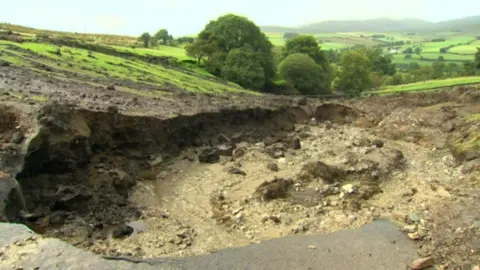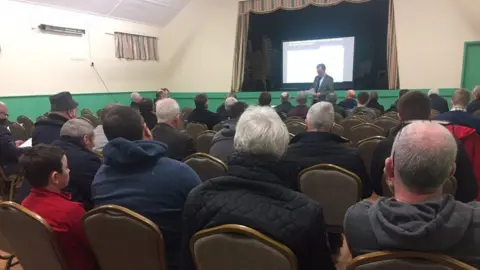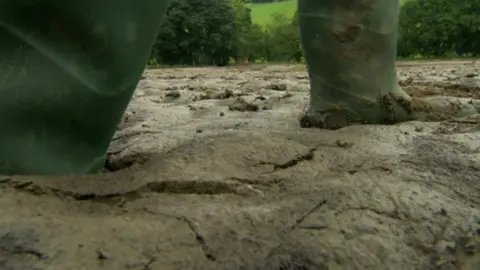Glenelly Valley landslides were 'one-in-3,000 year event'
 BBC
BBCA spate of landslides that killed livestock and destroyed farmland in County Tyrone last August were a one-in-3,000 year event, experts have said.
Thirteen landslides hit the Glenelly Valley near Plumbridge as at least 50mm of rain fell during a three-hour storm.
Scores of sheep were washed away and tonnes of silt and rubble were dumped on fields at the foot of the mountains.
A concentrated spell of very heavy rain had made the peat on the side of the glen unstable, said Dr Alan Dykes.
The associate professor in Engineering Geology from Kingston University London investigated the cause of the landslide.
'Very rare event'
He said water had built up on a non-porous mineral layer under the peat, called an iron pan.
The pressure then caused the supersaturated peat to slide off it and down the mountain into the valley, he told a Plumbridge audience.

Dr Dykes said it had been a "very rare event" which was unlikely to be repeated.
He said the best thing to do was to allow the mountainside to regenerate naturally.
He added that for there to be any further risk of landslides an even more severe rain event would have to happen - something he considered very unlikely.
Silt-clearing operation
Dr Dykes, who has investigated landslides around the world, spent two days in the Glenelly Valley earlier this year.
Meanwhile, farmers in the area are still coming to terms with the impact of the storm.
Many fields are still covered in a thick layer of silt, sand and rubble washed off the mountain.

One of the worst farms affected belongs to Michael McCullagh - some 20 acres of his best land was destroyed by the floods.
He was quoted £20,000 to clear just one field of silt, he said, and that is money which he does not have.
Mr McCullagh said he had been told the the Department of Agriculture and Environment had drawn up a support scheme for farmers like him.
But he said they were unable to implement it in the absence of a minister.
Farmers should still be able to receive EU subsidies for most of the affected ground in 2018 under an exceptional circumstances clause called "force majeure".
However, they have to demonstrate how they plan to bring it back into use.
